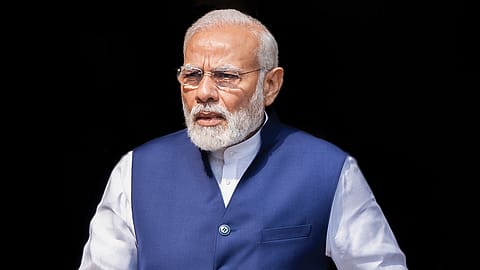PM Modi visits under-construction bullet train station at Surat; reviews progress
Prime Minister Narendra Modi visited the under-construction Bullet Train Station at Surat in Gujarat yesterday and reviewed the Progress of the Mumbai–Ahmedabad High-Speed Rail Corridor (MAHSR), with Union Minister Ashwini Vaishnaw accompanying during the visit.

Prime Minister Narendra Modi visited the under-construction Bullet Train Station at Surat in Gujarat yesterday and reviewed the Progress of the Mumbai–Ahmedabad High-Speed Rail Corridor (MAHSR). He also interacted with the team of India’s first Bullet train project and enquired about the progress of the project, including adherence to speed and timetable targets. Workers assured him that the project was advancing smoothly without any difficulties. Union Minister Ashwini Vaishnaw was present during the visit.
The MAHSR spans approximately 508 kilometres, covering 352 km in Gujarat and Dadra & Nagar Haveli, and 156 km in Maharashtra. The corridor will connect major cities, including Sabarmati, Ahmedabad, Anand, Vadodara, Bharuch, Surat, Bilimora, Vapi, Boisar, Virar, Thane, and Mumbai.
The project features 465 km (about 85% of the route) on viaducts, ensuring minimal land disturbance and enhanced safety. So far, 326 km of viaduct work has been completed, and 17 out of 25 river bridges have already been constructed.
Upon completion, the Bullet Train will reduce travel time between Mumbai and Ahmedabad to nearly two hours, making it faster, easier, and more comfortable. As per the statement, the project is expected to boost business, tourism, and economic activity along the entire corridor, catalysing regional development.
The Surat–Bilimora section, covering around 47 km, is in an advanced stage of completion, with civil works and track-bed laying fully completed. The station has been designed with a focus on passenger comfort, featuring spacious waiting lounges, restrooms, and retail outlets. It will also offer seamless multi-modal connectivity with the Surat Metro, city buses, and the Indian Railways network.
In an interaction with the on-ground team, an engineer from Kerala shared her experience of working at the Noise Barrier Factory in Navsari, Gujarat, where robotic units are being deployed for welding rebar cages. PM Modi asked her how she personally perceived the experience of building India’s first bullet train, and what they share with their families about this historic achievement. She said her family viewed the project with pride and a significant opportunity.
The prime minister emphasised contributing to the development of the nation, drawing a parallel with India’s space journey, recalling how the scientists who launched the country’s first satellite must have felt, and how today hundreds of satellites are being launched.
Recommended Stories
Another employee from Bengaluru, serving as lead engineering manager, explained the rigorous design and engineering control processes. She highlighted that at every stage of execution, her team evaluates pros and cons, identifies solutions, and explores alternatives to ensure flawless implementation.
Modi suggested recording and compiling similar to a Blue Book, which would benefit in scaling future bullet train initiatives. He emphasised that India must avoid repeated experimentation and instead replicate the learnings from existing models. “We will dedicate our lives here and leave behind something valuable for the country,” the Prime Minister affirmed.